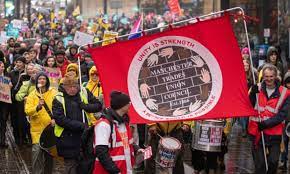Polly Smythe
At midnight on 25 January, warehouse workers at Amazon’s BHX4 in Coventry stopped sorting and scanning goods, walked away from their workstations, past management and security, and became the first workers to officially go on strike against the corporate giant in the UK. In taking their action, these workers joined striking Co-op Funeralcare coffin manufacturers in Glasgow, sewage plant attendants and flood forecasting officers at the Environment Agency, and security and visitor services staff at the British Museum in London, National Museums Scotland, and the National Museum of Liverpool.
These disputes, along with other settled and potential disputes, make up the current wave of industrial action in Britain. This episode of renewed labour militancy has been called everything from the unimaginative “winter of discontent” to the overwrought “general strike”. It spans all sectors, and strikes are happening or are on the cards in industries that aren’t traditionally strike-prone, such as charity and entertainment. And, unlike the biggest disputes in the 2010s – the public sector strikes of 2011 and 2014 – this time there is substantial private sector involvement.
In transport, strikes have been bringing trains, planes, buses, trams, and in the case of gig economy drivers for Uber and Bolt, taxis, to a halt. Unite has reported an 827% increase in strike action for bus drivers working for operators such as Arriva, Stagecoach and Abellio. The GMB has taken bus drivers out on strike in Sunderland and on Arriva’s north west route, as has the RMT in Somerset and Cornwall.
The strike wave has brought with it an entire generation who have never stood on a picket line before. The very act of organising and striking can be educative, transformative, and disruptive to ideas of what your job, union, and life are supposed to look like. During the 24-hour Amazon strike, a worker who arrived for his night shift instead became a GMB member on the spot, spending the evening on picket duty. Stopping HGV lorries, and asking them not to cross the picket line, he shouted “driver go back, no one’s inside, everyone’s here”.
Where workers are winning their pay demands, they’re largely seeing settlements below the level of inflation, which is still more than if they’d not taken strike action. Settlements often include one-off payments, which happened, for instance, at Shelter, the National Coal Mining Museum, and Felixstowe port. While bonuses provide immediate and genuine relief to workers and shouldn’t be sniffed at, they aren’t the same as permanent salary uplifts. The Office for National Statistics reported 467,000 days were “lost” to strikes in November, a 10-year high. At 323 in November, the number of strikes happening simultaneously is the highest it’s been since November 1978, the original “winter of discontent”.
Most strikes been limited to one or two days, although there have been a handful of indefinite strikes: criminal barristers, Jacobs Cream Crackers factory workersand tram drivers on the West Midlands Metro. In October, Unison members embarked on continuous strike action after a council house repair worker was denied sick pay by the Barnet Group after being injured at work. The long Conservative assault on the public sector has meant striking workers in healthcare, the civil service, and now in education and the fire brigade, are able to channel public frustration with disruption caused by disputes away from workers and towards the government. I’ve spoken to nurses who report better staffing levels on strike days, as the minimum safety levels agreed for life and limb cover are higher than everyday understaffed shifts.
The government seems to believe that settling one dispute will result in it having to settle them all, despite having already agreed a pay increase with criminal barristers last summer. Legislation introduced in July allowing agency staff to replace striking workers has already been used by some employers. The government has avoided engaging with the root cause of the disputes and instead introduced a draconian new law imposing minimum service levels on employees, while hiding behind pay review bodies.
On 1 February, the TUC’s “protect the right to strike” day, close to half a million workers went on strike, with civil servants, teachers, university staff and train drivers walking out. Outside Downing Street, children who’d joined a National Education Union rally wrote the names of their schools in chalk on the pavement. So far, this strike wave has seen limited coordination of action between unions, making this day both significant, and a reminder of the difficulties of meaningful coordination. Pat Cullen, the general secretary of the RCN, has clearly stated her opposition to coordinated action, saying “our days of action and future planning is based only on what is best for nursing”. Nurses will instead strike on 6 and 7 February.
Dissatisfaction with work has led not only to strikes but also to less coordinated forms of action in the shape of a high quit rate and chronic staff shortages. In November 2022, 13.3% of businesses surveyed by the Office for National Statistics reported experiencing a shortage of workers, with vacancies highest in social work and food services. Between last July and September, more than 1 million people moved from one job to another.
This high a quit rate can be suggestive of worker power – you don’t walk off your job without being fairly confident you’ll find another one – but it’s also a reminder that far too often workers navigate poor pay and conditions alone, leaving one bad situation for another. In this sense, that workers are resigned to the absence of trade unions from their lives. Non-union workers are seeing the victories being won by organised labour, making now a crucial moment for unions to reach out to those who want to improve their workplaces for themselves and their colleagues.







